Posts Tagged ‘Karen State’ (107 found)
Development for Whom?
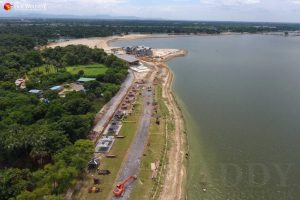
The impact of development projects on local communities and the environment in Burma has held considerable attention in the news over the last few weeks. On 26 August 2016, IFI Watch Myanmar, a local organization supporting the involvement of civil society and communities in monitoring the activities of international financial institutions, released a report entitled, “How Community Driven are CDD Projects in Myanmar?” on the implementation of the World Bank’s National Community Driven Development Project (NCDDP) […]
• • •Beautiful Words, Ugly Actions:The Asian Highway in Karen State, Burma
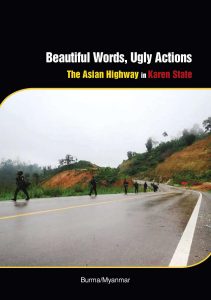 This is a joint-report from KHRG, THWEE Community Development Network, and Karen Environmental and Social Action Network (KESAN). It details human rights violations surrounding the construction of the Asian Highway in Thin Gan Nyi Naung to Kawkareik, Dooplaya District, which was completed in August 2015. These violations include the lack of Free, Prior and Informed Consent (FPIC) for affected communities, and armed conflict aggravated by construction, impacting civilians living along the Highway […]
This is a joint-report from KHRG, THWEE Community Development Network, and Karen Environmental and Social Action Network (KESAN). It details human rights violations surrounding the construction of the Asian Highway in Thin Gan Nyi Naung to Kawkareik, Dooplaya District, which was completed in August 2015. These violations include the lack of Free, Prior and Informed Consent (FPIC) for affected communities, and armed conflict aggravated by construction, impacting civilians living along the Highway […]
Asian Highway developments linked to conflict and displacement in Karen State
A new report by THWEE Community Development Network, the Karen Environmental and Social Action Network (KESAN), and the Karen Human Rights Group (KHRG) reveals how the brand new Asian Highway in Karen State has been built at the expense of communities who had the misfortune of standing in the way of transnational trade interests […]
• • •လူူမသိသူမသိဘ၀မ်ား – ျမန္မာႏိုင္ငံမွ လူမသိေသးေသာေနရပ္စြန္႔ခြာတိမ္းေရွာင္ရမႈ သံသရာ
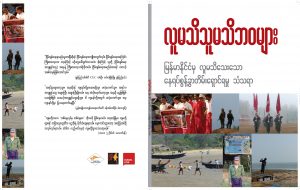 လတ္တေလာကာလ ျမန္မာ့အေရးႏွင့္ပတ္သက္လွ်င္ ဒီမိုကေရစီျပဳျပင္ ေျပာင္းလဲေရး၊ ၂၀၁၅ ေရြးေကာက္ပြဲႏွင့္ အမ်ိဳးသားဒီမုိကေရစီအဖဲြ႔ခ်ဳပ္ (NLD) ဦးေဆာင္ေသာအစိုးရ၏ အနာဂတ္တို႔ အေပၚသာ အာရံုစိုက္မႈမ်ားေနၿပီး အလြန္နက္နဲေသာ လူသားခ်င္းစာနာမႈ အက်ပ္အတည္း ႏွင့္ ျမန္မာႏုိင္ငံအေရွ႕ေတာင္ပိုင္းမွ တိုင္းရင္းသားလူနည္းစု အသိုင္းအဝိုင္းတို႔၏ ဆက္လက္စိုးရိမ္ပူပန္ေနရမႈမ်ားအား အမ်ားအားျဖင့္ လ်စ္လ်ဴ႐ႈထားၾကသည္ […]
လတ္တေလာကာလ ျမန္မာ့အေရးႏွင့္ပတ္သက္လွ်င္ ဒီမိုကေရစီျပဳျပင္ ေျပာင္းလဲေရး၊ ၂၀၁၅ ေရြးေကာက္ပြဲႏွင့္ အမ်ိဳးသားဒီမုိကေရစီအဖဲြ႔ခ်ဳပ္ (NLD) ဦးေဆာင္ေသာအစိုးရ၏ အနာဂတ္တို႔ အေပၚသာ အာရံုစိုက္မႈမ်ားေနၿပီး အလြန္နက္နဲေသာ လူသားခ်င္းစာနာမႈ အက်ပ္အတည္း ႏွင့္ ျမန္မာႏုိင္ငံအေရွ႕ေတာင္ပိုင္းမွ တိုင္းရင္းသားလူနည္းစု အသိုင္းအဝိုင္းတို႔၏ ဆက္လက္စိုးရိမ္ပူပန္ေနရမႈမ်ားအား အမ်ားအားျဖင့္ လ်စ္လ်ဴ႐ႈထားၾကသည္ […]
ျမန္မာအစိုးရ၏ ျပဳျပင္ေျပာင္းလဲေရးမ်ားသည္ တိုင္းရင္းသားေဒသမ်ားမွ ေနရပ္စြန္႔ခြာတိမ္းေရွာင္ရမႈ၏ အေျခခံ အေၾကာင္းတရားမ်ားကို ကိုင္တြယ္ေျဖရွင္းရမည္
ယေန႔ ၂၀၁၆ ခုႏွစ္ ၾသဂုတ္လ ၁၂ ရက္ေန႔ ရန္ကုန္ၿမိဳ႕တြင္ ထုတ္ျပန္သည့္ ဘားမားလင့္ခ္၊ ျမန္မာ့အေရး ပူးေပါင္းေဆာင္ရြက္သူမ်ားအဖြဲ႔ႏွင့္ မြန္ျပည္လူ႔အခြင့္အေရးေဖာင္ေဒးရွင္း (HURFOM) တို႔မွ ပူးတြဲထုတ္ေ၀ေသာ အစီရင္ခံစာတြင္ အစိုးရသစ္သည္ စစ္ပြဲႏွင့္ ေနရပ္စြန္႔ခြာတိမ္းေရွာင္ရမႈတို႔၏ အေျခခံအေၾကာင္းတရားမ်ားကို ကိုင္တြယ္၍ ေနရပ္ျပန္ေရး အဟန္႔အတားမ်ားကို ဖယ္ရွားျခင္းျဖင့္ ျမန္မာႏိုင္ငံ အေရွ႕ေတာင္ပိုင္း နယ္စပ္ တစ္ေလွ်ာက္မွ ျပည္တြင္းေနရပ္စြန္႔ခြာ တိမ္းေရွာင္ရသူမ်ားႏွင့္ ထိုင္း-ျမန္မာနယ္စပ္ရွိ ဒုကၡသည္မ်ားအတြက္ ေရရွည္တည္တံ့သည့္ ေျဖရွင္းခ်က္မ်ားကုိ ေဖာ္ေဆာင္အားေပး ျမႇင့္တင္သင့္ေၾကာင္း ေဖာ္ျပထားသည္ […]
• • •INVISIBLE LIVES: The Untold Story of Displacement Cycle in Burma
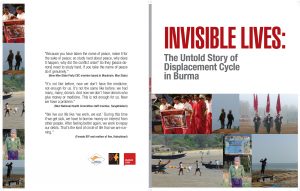 Recently, much attention surrounding Burma has focused on the democratic reform, 2015 elections and the future of the National League for Democracy (NLD)-led Government, whilst a profound humanitarian crisis and continuing concerns of the ethnic minority communities in the southeast have been largely ignored […]
Recently, much attention surrounding Burma has focused on the democratic reform, 2015 elections and the future of the National League for Democracy (NLD)-led Government, whilst a profound humanitarian crisis and continuing concerns of the ethnic minority communities in the southeast have been largely ignored […]
Hidden Strengths, Hidden Struggles: Women’s testimonies from southeast Myanmar
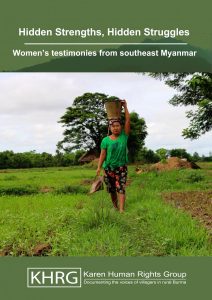 This report presents women’s testimonies in respect of various issues during the reporting period of January 2012 to March 2016. These issues include the dangers posed to women by the presence of armed actors in communities; the effects of land confiscation and development projects on women’s livelihoods; women’s access to healthcare and education; the continued occurrence of gender-based violence; and the harms caused by landmines; forced labour; arbitrary taxation and extortion […]
This report presents women’s testimonies in respect of various issues during the reporting period of January 2012 to March 2016. These issues include the dangers posed to women by the presence of armed actors in communities; the effects of land confiscation and development projects on women’s livelihoods; women’s access to healthcare and education; the continued occurrence of gender-based violence; and the harms caused by landmines; forced labour; arbitrary taxation and extortion […]
Hidden Strengths, Hidden Struggles: Women’s testimonies from southeast Myanmar
Today, at Summit Parkview Hotel in Yangon, Karen Human Rights Group (KHRG) launched its thematic report entitled Hidden Strengths, Hidden Struggles: Women’s testimonies from southeast Myanmar which projects the voices of local women from southeast Myanmar and aims to present a comprehensive picture of their changing roles and experiences in this time of ceasefire and democratic change […]
• • •Report Launch Introduction for KHRG Thematic report: “Hidden Strengths, Hidden Struggles: Women’s testimonies from southeast Myanmar”
KHRG has been preparing a new thematic report focusing on women’s issues entitled: Hidden Strengths, Hidden Struggles: Women’s testimonies from southeast Myanmar. We will be launching our report in Yangon in the first week of August 2016 [..]
• • •Achieving Health Equity in Contested Areas of Southeast Myanmar
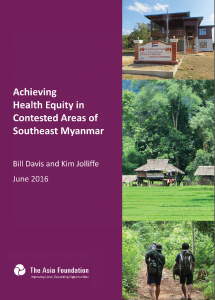 Throughout decades of ethnic armed conflict, the governance environment in many of Myanmar’s non- Burman areas has become deeply fractured, as ethnic armed organizations (EAOs) have established parallel governance systems, including healthcare departments. This report gives an overview of the parallel Ministry of Health (MoH) and EAO-linked health systems that exist in southeast Myanmar, and looks at how coordination and cooperation have increased since ceasefires were signed in 2011 and 2012 […]
Throughout decades of ethnic armed conflict, the governance environment in many of Myanmar’s non- Burman areas has become deeply fractured, as ethnic armed organizations (EAOs) have established parallel governance systems, including healthcare departments. This report gives an overview of the parallel Ministry of Health (MoH) and EAO-linked health systems that exist in southeast Myanmar, and looks at how coordination and cooperation have increased since ceasefires were signed in 2011 and 2012 […]









 All posts
All posts